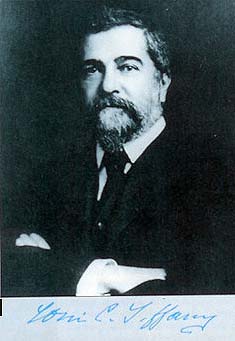
Album
of
Friends
click on the pictures to learn more
|
Album of Friends |
|---|
Emma Lazarus |
and a rare photo of the group |
|---|
| Rose was Nathaniel Hawthore's youngest daughter. She married George Lathrop and though she was trained as an artist, she became a writer like her husband and father. Richard wasn't fond of her writing, and rejected her work for his magazine. She was close to Emma Lazarus and George was part of Richard's group that got international copyright laws enacted in the U.S. They had one child that died at age four. When they were on hard times, Helena sent them money. Rose and her husband converted to Catholicism which caused a national stir. She later divorced George and became a nun to work with cancer patients. (Emma died of cancer) |
|
|---|
Wyatt Eaton |
Augustus Saint-Gaudens & family & friends |
Ole Sam & family |
|---|
Grover & Mrs. Cleveland |
Cecilia Beaux |
|---|
Joe Jefferson |
Jeannette Gilder |
|---|
Charles Dudley Warner |
William Merritt Chase |
|---|
Charles Dudley Warner was Mark Twain's partner in crime in writing "The Gilded Age" William Merritt Chase was the Andy Warhol of his time and defined 'the artist as presence' |
|---|
John La Farge |
Helena Modjeska |
|---|
"These evenings were the most delightful gatherings I have even known. Mrs. Gilder brought in her knitting. She had lived in Dresden or Munich and she had something of the simplicity of the German life. There were ladies in evening gowns, and some men with foreign decorations and that kind of thing. At a certain time chocolate and biscuits were served, and everyone stayed until the last moment. In New York at that time there was little lavish entertainment except at formal dinners, and the courses at these seemed to be without end. You imagined that dinner was finished with the sherbet, but that meant it was only to begin again and finally complete itself with the favorite Nesselrode pudding and liqueurs. On one occasion it had grown very late; nearly all the guests had gone when a few of us who had been asked to stay, were informed that Count Bozenta and Modjeska were coming, and that Modjeska was to recite a tirade in Polish from 'Cleopatre'. Miss Julia deKay and I had always been great pals. Some were afraid of the lady, for she had a tongue like lightning; but I looked on her as particularly Irish, and we always managed to have an amusing time. There was a great Cocoa-matting screen dividing the big room of the studio into two parts, and on this evening Julia and I were sitting just at the end of the screen. Suddenly she said to me: 'I shouldn't be surprised if Helena was not going to offer us any supper tonight, because its so late. Its nearly half past twelve.' And then, after a look behind the screen, she said, 'I was a prophetess. There's Sauterne in an ice-cooler and plates of iced oysters and chicken on the shelf here. I must go soon. Suppose we drop quietly behind the screen and have our supper now.' To hear was to obey. We emptied half the bottle of Sauterne and managed to consume the oysters and some of the chicken. Suddenly Modjeska, still wearing the costume of 'Frou-Frou' and her wig, entered accompanied by the Count. Helena Gilder was delighted. 'Before we begin any conversation,' she said, 'the Count and you must come behind the screen and have something to eat; you are tired.' Julia deKay looked at me with horror-striken eyes. 'My God,' she said. 'I must go,' and she went, and I followed as quickly as I could. As to what happened after this, we never inquired. It would have been a great mistake for us not to preserve the greatest secrecy." [around 1875] from: "Recollections of a Happy Life" by Maurice Francis Egan |
|---|
Stanford White |
Eleonora Duse |
|---|
William James |
Henry James |
|---|
1860-1861 - The James family returned from Europe so that William could study painting with William Morris Hunt, Newport, R.I. Henry, only a year younger, also studies painting. John La Farge and Hunt are both living in Newport. La Farge was older than the James and had already studied in Europe with other artists. After half a year, William decided he was not gifted, perhaps more because of guilt feelings than a lack of talent, and, obeying his father's wishes, entered Harvard and began the study of chemistry. Before William James entered the Lawrence Scientific School at Harvard University to begin medical school at the age of 19, he was familiar with nearly every major museum in Europe and was fluent in five languages. William began his studies at Harvard at the same time that the American Civil War began to rage. Although his brothers Wilky and Bob enlisted, William and Henry Jr. did not, pleading health issues—William suffered from neurasthenia and a host of ailments, including weak vision, digestive disorders, and a severe depression that brought about thoughts of suicide. In Henry James' autobiography, he connected the national agony of the war to "a horrid even if an obscure hurt" he suffered while fighting a fire in Newport, Rhode Island, in the fall of 1861, six months after the war began. Leon Edel, the most thorough of the James scholars, has concluded that the obscure hurt was some sort of back injury: "a slipped disc, a sacroiliac or muscular strain--obscure but painful as such injuries can be. That the hurt was exacerbated by the tensions of the Civil War seems quite clear. . . . Henry found himself a prey to anxieties over the fact that he might be called a malingerer, and had a feeling that he was deficient in the masculinity being displayed by others of his generation on the battlefield" By 1864, the entire James family was relocated to Cambridge, Mass. |
|---|

"I was fond of Mr. Gilder, and sometimes Sallie and I dined with him and his family down near Twelfth Street in a lovely museum of a house, furnished with rosewood furniture, rather scantily upholstered, and where we ate on heavy damask linen, with beautiful silver and exquisite china, all out of the reconstruction days. Gilder was one of the last living survivors of the New York mugwumps whom Theodore Roosevelt secretly adored and openly scorned. They rallied around Grover Cleveland, and he was a familiar of the house. At dinner with us there, one found the poets and novelists of the eighties...Today, when I read their books, I think of Mary Murfree there at that Gilder dining table, serene in her maiden reserves, gentle but a bit snobbish at times, with her eager birdlike face under the candlelight in the dark walnut-paneled room, with all of us about her in most respectable evening clothes, and considering a world that was about to blow to-hell-and-gone." [around 1907] From "The Autobiography of William Allen White" |
|---|
|
Alma Strettell, later Alma Strettell Harrison 1856-1939
|
|---|
 Will Low's Self-Portrait
Will Low's Self-Portrait 
PHOTOS
Walt Whitman- Photo by Jeanette Gilder |
John Burroughs- Photo by Richard Gilder |
Mark Twain & George Washington Cable |
Paul Wayland Bartlett's Bust of Walter Shirlaw |
|
 |
From a cigar box cover
|
 |
"Van Rensselaer had an elite upbringing in New York that included tutors at home and a year in Dresden with her family to finish her education. In 1884 her husband, suffering a lung disease, died, leaving her a widow with one young son at the age of thirty-three. (She wore black until her death at eight-three in 1934) Van Rensselaer had decided as early as 1876 to become a critic. A strident critic of John Ruskin, she championed the rebel Society of American Artists, Prolific and accomplished, in a twenty-year period she wrote, among other works, 13 books and more than 230 articles. She lost her son to TB in 1894." from: Oscar Wilde's America by Mary Warner Blanchard Richard died in her house. He grew ill as the Gilders were moving into a new house, and they moved him there to be more comfortable and out of the hub-bub of moving. |
Thomas Moran was a childhood friend of Richard's. At Gilder's suggestion, the Morans moved to Newark in 1872 in order to be available for the illustrative work which would be forthcoming from Scribner's. Thomas's wife, Mary, was an accomplished artist in her own right.
|
 |
Kate Field |
|---|